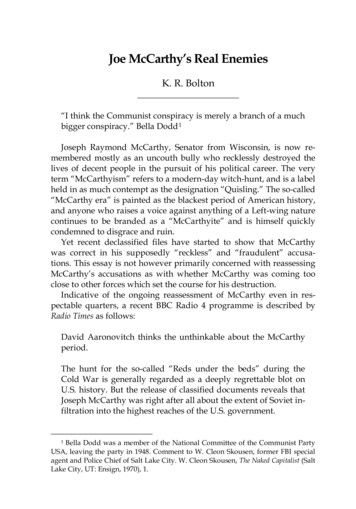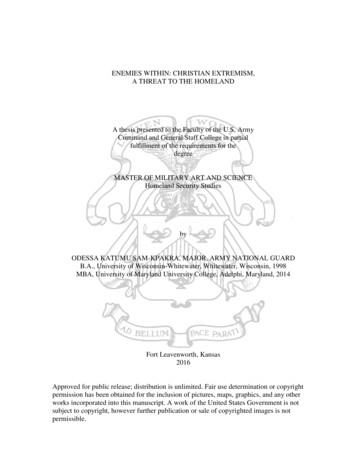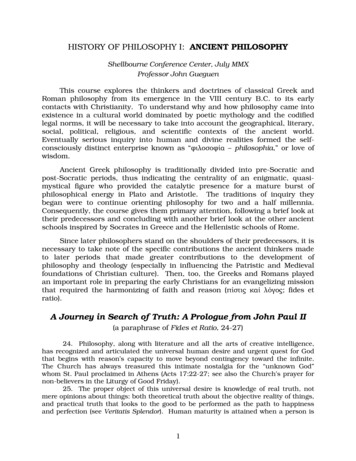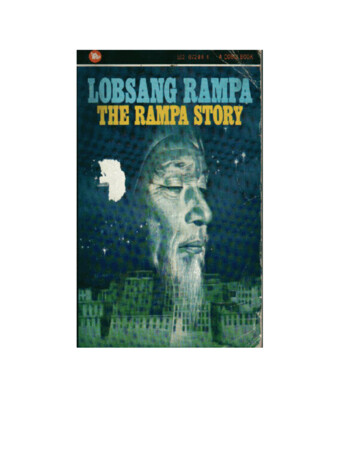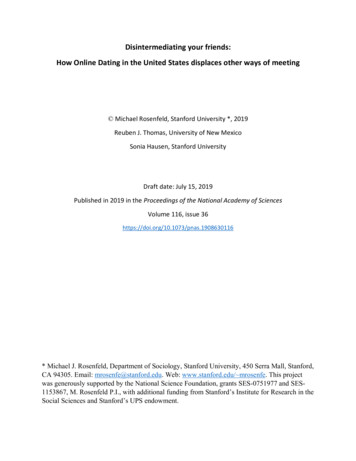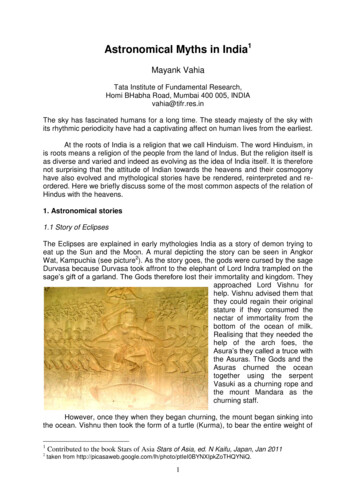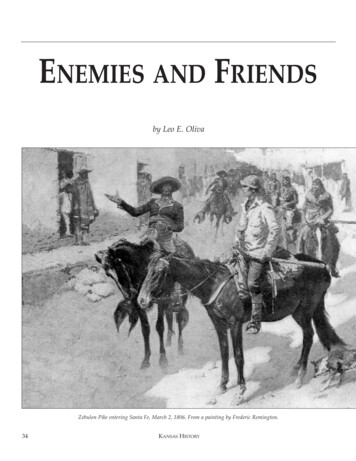
Transcription
ENEMIES AND FRIENDSby Leo E. OlivaZebulon Pike entering Santa Fe, March 2, 1806. From a painting by Frederic Remington.34KANSAS HISTORY
Zebulon Montgomery Pike andFacundo Melgares in theCompetition for the Great Plains,1806–1807The story of Lieutenant/Captain1 Zebulon Montgomery Pike’s expedition across the Great Plains to the Rocky Mountains (1806–1807), evencompared with the much more famous Corps of Discovery led byMeriwether Lewis and William Clark (1804–1806), is an outstandingrecord of exploration for the United States through a portion of the LouisianaPurchase. Pike helped the young nation later claim and eventually fulfill thatclaim to the Southwest (including Kansas and all or portions of eight otherstates). Just as remarkable and much less known and understood is the expedition of Lieutenant Facundo Melgares and his Spanish troops from New Mexicoto the Great Plains just prior to Pike’s venture. Pike became aware of the Spanish mission to the Great Plains when he arrived at the Pawnee village on the Republican River in present Nebraska, where Melgares had visited a few weeksearlier. Pike’s party followed the return route of Melgares south to the ArkansasRiver and along that stream into present Colorado to the point where theSpaniards left that river to head back to Santa Fe. It is interesting that almosteverything known about Melgares’s 1806 trip comes from Pike’s journal, for therecords of that Spanish expedition have not been found (it is possible they weredestroyed by a fire at the archives in Chihuahua City).The tale of these two expeditions and their respective leaders became moreintertwined after the capture of Lieutenant Pike’s exploring party near the RioGrande in present southern Colorado and his detention in Santa Fe and Chihuahua, during a portion of which time Lieutenant Melgares was Pike’s guard,overseer, and guide. The two enemies, for such they were as military officers ofcompeting nations at a time when Spain and the United States feared war between them might break out any time, became friends. Pike learned muchabout the Great Plains and the provinces of northern New Spain from MelLeo E. Oliva, a former university professor, is editor and publisher of the Santa Fe Trail Association quarterly, Wagon Tracks, and serves on the Zebulon Pike Bicentennial Commission.1. Pike, First U.S. Infantry, was promoted from lieutenant to captain during his expedition, effective August 12, 1806. Because he did not learn of it until his return to the United States the following year, he was referred to as Lieutenant Pike during his entire expedition. To avoid confusion,that rank will be used throughout this article, although he officially was Captain Pike before he arrived in present Kansas.Kansas History: A Journal of the Central Plains 29 (Spring 2006): 34–47.ENEMIES AND FRIENDS35
gares, and that information along with Pike’s own astuteobservations of the people and culture of the region, published in his journal of the expedition in 1810, sparked increased interest in the United States to attempt to opentrade with New Mexico. Spain thwarted those trading efforts as long as it retained control of the colony of NewSpain (later Mexico) but following Mexican independencefrom Spanish rule in 1821 both the United States andnorthern Mexico realized fruitful economic results. It issafe to declare that everyone who ventured forth from theUnited States to establish contact with northern Mexicoafter 1811 benefited either directly or indirectly from Pike’sexpedition and journal (including information providedby Melgares). Facundo Melgares, governor of New Mexicofrom 1818 to 1822, welcomed the first successful U.S. tradeexpedition to Santa Fe in 1821.Their respective governments sent both Pike and Melgares with a major purpose of securing friendship, traderelations, and alliances with several Indian tribes of the region, including the Osages, Kansas, Pawnees, and Comanches. The United States especially directed Pike toopen talks with the leaders of the Comanche tribe becauseof the tribe’s close ties to New Spain. The policy of seekingIndian spheres of influence was not new and had beenused by all nations involved in the contest for North America. The governments considered Indian allies to be the keyelement to establish effective control and eventual domination of a vast region, including present Kansas.France, which initially was most successful in developing alliances with the Indians of the region (except forthe Comanches who remained in the Spanish sphere of influence), was eliminated as a contender for control ofNorth America at the close of the French and Indian War(Seven Years’ War in Europe) concluded by the 1762 Treatyof Paris.2 Both Britain and Spain competed for favors withthe tribes, and the new United States entered the contestafter winning independence from Britain by the 1783Treaty of Paris. England continued to trade with the PlainsIndians, but the main contest, after the sale of LouisianaTerritory to the United States in 1803, was between the2. Donald A. Nuttall, “The American Threat to New Mexico,1804–1821” (master’s thesis, San Diego State College, 1959), 17; see alsoHenry Folmer, Franco-Spanish Rivalry in North America, 1524–1763 (Glendale, Calif.: Arthur H. Clark Co., 1953); Abraham P. Nasatir, ed., BeforeLewis and Clark: Documents Illustrating the History of the Missouri, 1785–1804,2 vols. (1952; reprint, Lincoln: University of Nebraska Press, 1990).36United States and Spain. Immediately the United States increased efforts to establish, gain, and consolidate controlover the trade with these various tribes (many of whomwere traditional enemies), thereby hoping to establishdomination of the tribes and the lands they occupied. Onthe opposing side, Spain pursued trade and alliances withPlains tribes and attempted to use them against the United States.3A critical issue in this pursuit of control was the establishment of the boundaries of the Louisiana Purchase.Spain refused to recognize the sale of Louisiana to theUnited States by France, claimed almost everything westof the Mississippi River, and prohibited U.S. citizens fromentering the territory. The United States wished to pushthat boundary as far west as it could, certainly to the RockyMountains and, if possible, all the way to the Rio Grandein the Southwest and the Pacific Ocean in the Northwest.The boundary issue remained unsettled until theAdams–Onís Treaty of 1819, also known as the Transcontinental Treaty.4 For all these reasons the expeditions led byMelgares and Pike comprised an important round of an expanded contest for a huge portion of North America between those two nations. The United States quickly wonthe contest, thanks especially to Lieutenant Pike but also toNapoleon Bonaparte who sold Louisiana to the UnitedStates and, perhaps more important, occupied Spain from1808 to 1814, during and after which the Spanish empire inthe New World fell into rapid decline.5Although they never encountered each other on thePlains, the paths of Melgares and Pike met up at the villageof the Pawnees on the Republican River in present southern Nebraska. Their respective relations with the Indiansof the region compose part of this story, along with a briefsummary of the two expeditions and the later friendship ofthese two army officers, which had several ramifications.Additional background will help readers understand the importance of the Melgares and Pike expeditions and what was at stake on the GreatPlains. It provides insight into apprehensions the Spanish3. See Abraham P. Nasatir, Borderland in Retreat: From Louisiana to theFar Southwest (Albuquerque: University of New Mexico Press, 1976);Charles L. Kenner, A History of New Mexican – Plains Indian Relations (Norman: University of Oklahoma Press, 1969), 66 – 68.4. Nasatir, Borderland in Retreat, 136 – 37.5. Warren L. Cook, Flood Tide of Empire: Spain and the Pacific Northwest, 1543 – 1819 (New Haven: Yale University Press, 1973), 450, 491, 516.KANSAS HISTORY
held about Pike and other U.S. explorers as well as whatthe United States hoped to achieve in the American West.Although Spain’s Francisco Vásquez de Coronado was thefirst European to explore the Great Plains, including portions of Kansas, Spain was not a major contender in thecontest for this region during the era of European colonialtrade arrangements with many tribes, including the Osages, Kansas, Pawnees, and others. They could not, however, win over the Comanches, with whom, after 1786,Spain held dominion.6Spain continued to consider New Mexico and lands tothe north and east as a buffer zone where foreign threatsSpain refused to recognize the sale of Louisiana to the United States and claimed almost everything west of the Mississippi River. The United States wished to push that boundary as far west as it could, to the Rocky Mountains and, ifpossible, all the way to the Rio Grande in the Southwest and the Pacific Ocean in the Northwest. The boundary issueremained unsettled until the Adams–Onís Treaty of 1819, also known as the Transcontinental Treaty.competition for control of North America—a contest thatinvolved Spain, France, Britain, and the Netherlands.Spain did explore and establish claim to much of the western portion of North America but did not establish settlements on the Plains following Coronado’s 1541 expeditionor Don Juan de Oñate’s expedition to present Kansas in1601. Instead, the French, with their aggressive policies ofexpanding trade and influence with tribal Americans, became the first and most successful in winning alliances andcould be countered before they reached more economically important locales, such as Chihuahua.7 Following the removal of France from the competition for the Great Plainsat the close of the French and Indian War, Spain acquiredFrench Louisiana and worked to become the favored trad6. Nasatir, Before Lewis and Clark, 1:2, 17, 19, 50; Kenner, A History ofNew Mexican – Plains Indian Relations, 52 – 58.7. Nuttall, “The American Threat to New Mexico,” 12.ENEMIES AND FRIENDS37
ing partner of those tribes with whom the French had heldsway. Spain’s major competition was Britain and, after1783, the new United States, which soon developed greatinterest in the region west of the Mississippi Valley and inopening the Mississippi River to navigation for its citizens.The young and vigorous United States had time and ener-François Hector, Baron de Carondelet, governor of SpanishLouisiana recognized the potential threat of the United States andwarned his superiors in Madrid that efforts should be made to counteract U.S. trans-Mississippi interests.gy on its side against the declining colonial, mercantilistempire of Spain.8The potential threat of the United States concernedsome Spanish officials. In November 1794 François Hector,Baron de Carondelet, governor of Spanish Louisiana,warned his superiors in Madrid that efforts should bemade to counteract the trans-Mississippi interests of theUnited States, warning that, if they were not stopped, “intime they will demand the possession of the rich mines ofthe interior provinces of the very kingdom of Mexico.” He8. See Cook, Flood Tide of Empire, 255 – 67.38declared the United States was “advancing with an incredible rapidity.” Carondelet recognized the importance ofkeeping the Indian tribes friendly to Spain and in opposition to the United States. He proposed “one hundred thousand pesos increase annually for the Indian department, forthe purchase of arms, ammunition, and presents, which arenecessary to employ the nations with efficacy.” He also outlined a detailed plan to defend Louisiana against the United States.9In 1794 Carondelet authorized the creation of a newcompany of merchants in St. Louis (commonly called theMissouri Company) under the leadership of Santiago(Jacques) Clamorgan, to expand trade with Indian tribesand explore the Missouri Valley to seek a passage to the Pacific (the same mission President Thomas Jefferson assignedto Lewis and Clark a decade later). Despite several attemptsto find a passage to the Pacific, the company failed.10The United States continued to pressure Spain to openthe Mississippi River to navigation. Spain, feeling morevulnerable because of changes in the balance of power inEurope and facing possible war with Britain, agreed to the1795 Treaty of Lorenzo el Real (also called the Treaty ofFriendship, Boundaries, and Navigation but best known asPinckney’s Treaty) and granted concessions to the UnitedStates by opening the lower Mississippi to commerce.11 Thefollowing year Governor Carondelet informed the Marquisde Branceforte at New Orleans that this treaty did not stopU.S. citizens from entering lands west of the MississippiRiver.Your Excellency will see himself obliged to take beforehand the most active measures to oppose the introduction of those restless people, who are a sort ofdetermined bandits, armed with carbines, who frequently cross the Mississippi in numbers, with the intention of reconnoitering, of hunting, and if they likethe country, of establishing themselves in the Provincias Internas, whose Indians they will arm to both further their fur trade and to make the Spaniards uneasy.12A few years later, because of the French Revolution andNapoleon’s desire to regain control of Louisiana, Spain re9. Carondelet quotation in James Alexander Robertson, ed., LouisianaUnder the Rule of Spain, France, and the United States, 1785–1807, 2 vols.(Cleveland: Arthur H. Clark Co., 1911), 1:294, 298, 300, 301–45.10. Cook, Flood Tide of Empire, 435 – 41.11. Ibid., 269 – 70.12. Carondelet quotation in Nasatir, Before Lewis and Clark, 2:440.KANSAS HISTORY
alized it could not defend Louisiana if Britain decided totake it. Consequently, in 1800 Spain returned Louisiana toFrance in an agreement kept secret for nearly two years.France agreed Louisiana could never be sold to a thirdparty, only back to Spain.13When Napoleon sold Louisiana to the United States in1803, Spain refused to recognize the deal because it violated the terms by which the territory had been returned toFrance. Spanish officials also prepared to meet U.S. expansion into the disputed lands. President Jefferson, determined to explore the West in the face of Spain’s objections,set the Lewis and Clark Expedition into motion prior to theLouisiana Purchase. Lieutenant Pike’s Southwest Expedition would also be part of that effort, even though GeneralJames Wilkinson authorized it. Jefferson approved Pike’smission and praised its accomplishments. Spanish officialsbecame fearful of intrusions, some even expecting an actual invasion, from the United States.14Spain continued to value the Indian tribes in the contest for territory, and trading efforts continued. On May 18,1804, Sebastián Calvo, Marquis de Casa Calvo, former military governor of Louisiana and later member of theLouisiana boundary commission, informed his superiorsthat “the Indians all have a decided preference in favor ofour nation, from which we can derive advantages if wenurse with tenderness their hatred for the Guachimangal(American).”15 The United States also looked to the Indiansfor assistance. On May 14, 1804, Louisiana GovernorWilliam C. Claiborne directed this military commander atthe Ouachitas Post in the territory:It is expected that everything will be done by you to13. Cook, Flood Tide of Empire, 442 – 44.14. Donald Jackson, ed., The Journals of Zebulon Montgomery Pike, withLetters and Related Documents, 2 vols. (Norman: University of OklahomaPress, 1966), 2:300–1; Nuttall wrote: “From the time of the first French arrivals, foreign intrusions into New Mexico were opposed by theSpaniards. They were not only in violation of Spain’s restrictive colonialpolicies but were looked upon as a threat to the province’s security. ThisSpanish anxiety attained its apogee during the period under consideration [1804–1821]. Following the acquisition of Louisiana by the UnitedStates, Spain grew increasingly apprehensive of that expanding nation’sdesigns on the land of her American empire. One of the principal manifestations of this phobia was the anticipation of an American invasion ofNew Mexico. The threat was illusory, but it was very much a reality to theSpaniards, and, as such, exerted considerable influence upon New Mexico in the ensuing years. Reaction to the American menace became, in fact,one of the salient features of the province’s existence.” See Nuttall, “TheAmerican Threat to New Mexico,” v.15. Calvo quotation in Robertson, Louisiana Under Spain, France andthe United States, 2:192; see also Nasatir, Before Lewis and Clark, 1:108 – 13.Indians, and that in their trade with the merchants,no injustice be done them. In your conversations withthese Indians, you will speak of the friendly disposition of the President of the United States to his redchildren, and his great desire to see them happy. Youwill add that the Americans are now their brothersand they must live in peace and friendship, as onefamily.16It should be emphasized again that the boundary ofLouisiana remained undefined; in fact, neither France norany other nation had ever designated the western limits ofthe territory. Thus a contest between Spain and the UnitedStates to determine that line encouraged exploration anddevelopment of better relations with Indians of the region.Spain claimed the Mississippi River as the boundary, whilethe United States pushed for the Rio Grande. As previously noted, Spain and the United States reached a compromise in 1819, but immediately following the LouisianaPurchase in 1803 both sides sought to improve their respective claims to portions of the region. Both Melgaresand Pike participated in that endeavor.General James Wilkinson, head of the U.S. Army andalso a paid agent for the Spanish government, sent a secretwarning to Spanish officials in the late winter of 1804 aboutthe Lewis and Clark Expedition and suggested how Spaincould protect her claims from U.S. intrusions. He wrote,“an express ought immediately to be sent to the governorof Santa Fé, and another to the captain-general of Chihuaga [Chihuahua] in order that they may detach a sufficientbody of chasseurs to intercept Captain Lewis and his partywho are on the Missouri River, and force them to retire ortake them prisoners.” Wilkinson emphasized the importance of Spain “winning the affection” of various Indiantribes and “increasing their jealousy against the UnitedStates.” By providing arms and ammunition to the Indians,Spain could employ them “not only in checking the extension of American settlements, but also, if necessary, in destroying every settlement located west of the Mississippi.”Wilkinson also warned against U.S. incursions in Texasand New Mexico, suggesting that Spain insist that the Mississippi River be the boundary between Spain and theUnited States.17Wilkinson declared,16. Claiborne quotation in Robertson, Louisiana Under Spain, Franceand the United States, 2:192n.17. Wilkinson quotation in ibid., 2:337 – 42.ENEMIES AND FRIENDS39
It is very probable that the United States will demandpossession of one part of the right [west] bank of theMississippi, in order to check the smuggling that willnecessarily prevail if the above-mentioned side belonged to any other nation, and also to favor the collection of its revenues. The true policy of Spain requires obstinate resistance to such a demand by asking[for] the right bank of the Mississippi in its entirety.He even recommended that Spanish troops be sent todestroy Daniel Boone’s settlement on the Missouri River. Infact, all settlers from the United States located west of theMississippi should be destroyed because, “if those settlersbe allowed to advance, they will very quickly explore theright path which will lead them to the capital of Santa Fé.”18It is not clear if Wilkinson was just betraying Lewis andClark, Jefferson, and the United States, or, as Warren Cookobserved, “the possibility must not be overlooked that,rather than aiding Madrid, he may have been setting thestage for incidents that would provide an excuse to declarewar and invade Spanish borderlands.”19Thus Spanish troops set out to intercept Lewis andClark, and some of these arrived in present Kansas afew weeks ahead of Zebulon M. Pike’s expedition in1806. Lewis and Clark escaped all contact with Spanishtroops, but Pike followed in their footsteps from thePawnee village in present Nebraska to the point where theSpanish troops left the Arkansas River in present Colorado.Later Spanish troops and government officials took Pikeinto custody and detained him. General Wilkinson undoubtedly contributed to the search for and capture of U.S.explorers—in this case the very man he sent to find thesources of the Arkansas and Red Rivers and who attempted to open friendly relations with several tribes of Indians.Initially, in January 1804, Calvo directed Spanish Governor Carlos Dehault Delassus at St. Louis to permit Lewisand Clark to proceed without opposition. “You will not putany obstacle to impede Capt. Merry Weather Lewis’ entrance in the Missouri whenever he wishes,” Calvo stated.20However, after hearing from General Wilkinson, Calvo sentan overland express to General Nemesio Salcedo, commandant of the Interior Provinces located in Chihuahua, with18. Ibid., 2:342–43, 345.19. Cook, Flood Tide of Empire, 453 – 54.20. Nasatir, Before Lewis and Clark, 2:725.40Wilkinson’s warnings and declared, “The only meanswhich presents itself is to arrest Captain Merry Weatherand his party, which cannot help but pass through the [Indian] nations neighboring New Mexico.”21General Salcedo received the message in early Mayand directed New Mexico Governor Fernando de Chacónto seek help from the Plains Indians in turning back Lewisand Clark and to send Spanish troops to arrest the Corpsof Discovery. Governor Chacón was encouraged to solicitPedro Vial for assistance because Vial had earlier traveledthe region. Vial was a native of France who had performedseveral exploring expeditions on the northern frontier ofNew Spain, including opening a route between Santa Feand San Antonio, another route between Santa Fe andNatchitoches, and a route across the Great Plains fromSanta Fe to St. Louis and back.22 From 1804 to 1806 four expeditions left Santa Fe to try to find and arrest Lewis andClark, without success. In February 1807 another expedition, this one successful, was sent to apprehend Pike andhis party.In August 1804 Pedro Vial, translator José Jarvet, andfifty men headed north from Santa Fe.23 A month later, onthe Platte River in present Nebraska, they met up with thePawnees, who earlier had become trading partners withNew Spain (perhaps in the early 1780s). The Spanish didnot find Lewis and Clark, but they urged the Pawnees notto trade with the United States and to turn back anyonecoming from there. Pawnee Chief Sharitarish (White Wolf),whom Pike would meet in 1806, welcomed the Spanishand encouraged the trade. A dozen Pawnees accompaniedVial and his party back to Santa Fe, where they arrived inearly November.24 Attempts to bind the Pawnees closer toSpain appeared to be succeeding.In 1805 General Salcedo directed Santa Fe’s new governor, Joaquín del Real Alencaster, to send troops to find“Captain Merry” or persuade the Indians to seek and capture Lewis and Clark. Alencaster, especially charged withseeking better relations with Indian tribes, particularly thePawnees, to prevent U.S. intrusions, dispatched Vial,Jarvet, and fifty-two men to pursue those missions. Alen21. Ibid., 2:731; Cook, Flood Tide of Empire, 455.22. Cook, Flood Tide of Empire, 456–58; Noel M. Loomis and AbrahamP. Nasatir, Pedro Vial and the Roads to Santa Fe (Norman: University of Oklahoma Press, 1966), 262 – 87, 316 – 415.23. Ruth Steinberg, “José Jarvet, Spanish Scout and Historical Enigma,” New Mexico Historical Review 67 (July 1992): 232.24. Cook, Flood Tide of Empire, 462 – 65.KANSAS HISTORY
caster directed Jarvet and Vial to remain with the Pawneesthrough the coming winter and watch for Lewis and Clarkas well as to cement relations with the tribes. Jarvet was toaccompany the chiefs to Santa Fe in the spring while Vialremained to move closer to the Missouri River, seek information about Lewis and Clark, and arrest them if possible.Near the junction of the Purgatory and Arkansas Rivers,Indians (later confirmed to be Skidi Pawnees) attacked theparty, which had been joined by others for a total of slightly more than one hundred men (including five recent migrants from the United States who were to proceed to Missouri as spies and later report to Santa Fe). The Spaniardslost most of their supplies, and one man was wounded.Unable to continue, the expedition returned to Santa Fe.Vial recommended the establishment of a fort on theArkansas River.25Spanish officials believed the United States was winning influence with some of the Plains tribes and probablyhad encouraged those who attacked Vial’s party. ThePawnees did not come to Santa Fe in the autumn of 1805 totrade, as they had in previous years, and this too the Spanish attributed to the growing U.S. influence. Another expedition from Santa Fe set out under leadership of Vial andJarvet in April 1806, but within a month they returned because many of their troops had deserted. Vial was now discredited.26Then Spain perceived another threat from the UnitedStates. President Jefferson sent an expedition, planned byWilliam Dunbar and led by Thomas Freeman and CaptainRichard Sparks, with twenty-two men, to explore the RedRiver to its source. They carried a Spanish passport issuedby Calvo, who insisted that some Spanish subjects accompany them, including a planted spy, Tomás Power. General Salcedo, however, notified Calvo that he would nothonor the passport and would not permit the U.S. explorers to enter Spanish territory. Also, orders from Spainreached Salcedo in February 1806, urging him again to stopLewis and Clark and turn back other attempts to intrudeon Spanish territory. That same month U.S. troops tookpossession of the Spanish outpost at Los Adaes in Texas,only fourteen miles from Natchitoches in Louisiana. Spainviewed such U.S. aggression as almost an act of war.2725. Ibid., 465–69.26. Ibid., 470–72.27. Ibid., 472–76.LClearly, tensions were increasing between the two countriesin the region where Zebulon M. Pike would soon venture.ieutenant Melgares led the fourth expedition, sentfrom New Mexico on June 15, 1806, to stop “CaptainMerry.” It was, according to one historian, “theThe Spanish urged the Pawnees not to trade with theUnited States and to turn back anyone coming fromthere. Pawnee Chief Sharitarish (above), whom Pikewould meet in 1806, welcomed the Spanish but opposedlargest Spanish force ever sent onto the Great Plains.” Melgares, with sixty additional soldiers, had been sent by General Salcedo from the presidio of San Fernando de Carrizalsome seventy-five miles south of El Paso to Santa Fe, atGovernor Alencaster’s request, to help deal with the Indians who had stopped Vial and Jarvet from reaching thePlains. Melgares carried with him orders to turn back theFreeman–Sparks expedition on the Red River, if that hadnot already been accomplished by other troops from Texas,and then proceed northward to try to intercept Lewis andClark and meet with several Plains tribes (particularly thePawnee, Omaha, and Kansa) to seek closer ties with themENEMIES AND FRIENDS41
and urge them to reject overtures from the United States.Melgares set out with 105 soldiers, 400 New Mexican militia, 100 Indian allies, and more than 2,000 horses and mules.The size of this force was designed especially to impress thePawnees, whose loyalty to Spain seemed to be wavering,and secure their cooperation against U.S. citizens.28wealthy), having been born in New Jersey in 1779 as son ofa career army officer and himself a career officer. Pike mistakenly believed that Melgares had been sent out to searchfor him rather than for Lewis and Clark.30At Santa Fe the Spanish expedition received equipmentand supplies for six months. The large force traveled downthe Red River but did not meet upwith the Freeman – Sparks expedition; it had been turned back bytroops from Spanish Nacogdoches,led by garrison commander Francisco Viana, by order of General Salcedo. Melgares did meet some bandsof Comanches, who were still alignedwith Spain, and held council withthem.31 Melgares then headed northeast when, according to Pike whodisparaged the Spanish militia bystating, “it is extraordinary withwhat subordination they act,” approximately one-third of his forcesigned a petition requesting that theyproceed no farther and go backhome. Melgares reacted quickly andharshly, as Pike reported.He halted immediately, and causedhis dragoons to erect a gallows;then beat to arms. The troops fellin: he separated the petitioners fromthe others, then took the man whohad presented the petition, tied him up, and gave him50 lashes, and threatened to put to death, on the gallows erected, any man who should dare to grumble.This effectually silenced them, and quelled the risingspirit of sedition.32From 1804 to 1806 four Spanish expeditions left Santa Fe to try to intercept Lewis and Clark. Thefourth expedition was led by Lieutenant Melgares. The above drawing depicts a fully equipped cavalryman of New Spain.According to Pike, who later appended informationabout the Spanish expedition to his journal, Melgares camefrom an aristocratic family in Spain and was a career armyofficer who “had distinguished himself in several long expeditions against the Appaches and other Indian nations.”Pike noted, “he was a man of immense fortune, and generous in its disposal, almost to profusion; possessed a liberal education, high sense of honor, and a dispositionformed for military enterprise.”29 Born in 1775 in VillaCarabaca, Murcia, Spain, Melgares received an educationand training as a military officer. Pike, who clearly ad
ENEMIES AND FRIENDS 35 Zebulon Montgomery Pike and Facundo Melgares in the Competition for the Great Plains, 1806–1807 Leo E. Oliva, a former university professor, is editor and publisher of the Santa Fe Trail Associ- ation quarterly, Wagon Tracks, and serves on the Zebulon Pike Bicentennial Comm
